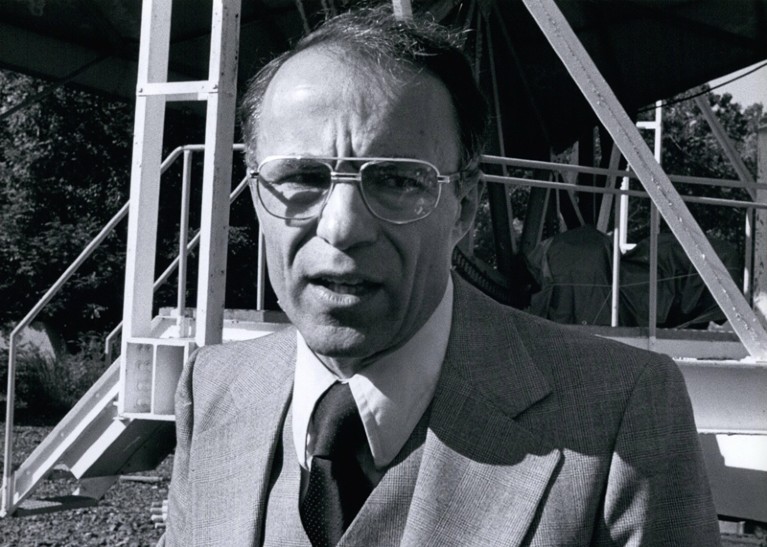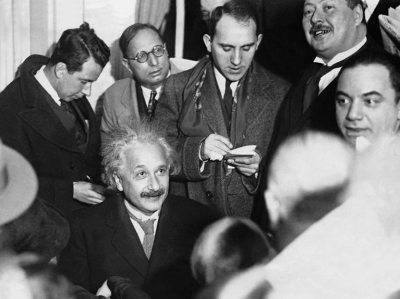
Credit: Keystone Press/Alamy
Arno Penzias and Robert Wilson made a pivotal discovery that altered humanity’s understanding of the Universe. In 1964, they detected the radio-frequency glow from the sky that became known as the cosmic microwave background. This observation confirmed the Big Bang model of the Universe and ushered in a new era of precision cosmology. For their discovery, Penzias and Wilson shared half of the 1978 Nobel prize for physics. Penzias has died aged 90.
He and Wilson went on to detect radio waves in the millimetre wavelength range that enabled them to identify molecules such as carbon monoxide (CO) and the hydrogen isotope deuterium in interstellar clouds of gas and dust, shedding light on the origins of stars and galaxies.
Penzias was born in 1933 in Munich, Germany, to Jewish parents of Polish descent. In 1938, the family was arrested by the Nazis and sent to Poland. Fortunately, the train was returned because Poland had stopped accepting Jews. Instead, in 1939, Arno and his four-year-old brother, Günther, were brought to England by a British children’s rescue group. His parents soon followed, and the family moved to New York City in 1940.

How Einstein built on the past to make his breakthroughs
After attending Brooklyn Technical High School, Penzias entered the City College of New York in 1951. He graduated with a physics degree in 1954. Following two years in the Army Signal Corps working on radar, he earned a PhD in physics at Columbia University, under the guidance of Charles Townes, inventor of the maser. In 1961, Penzias joined Bell Laboratories’ Radio Physics Research Department on Crawford Hill in Holmdel, New Jersey.
At the time, Bell Laboratories were conducting telecommunications experiments in space using Echo satellites — 30-metre-diameter Mylar balloons bouncing microwave signals from one point on Earth to another. A horn antenna with an aperture measuring 6 metres across was built on Crawford Hill to measure these microwave beams, and Penzias and Wilson used it to study emissions from the Milky Way. In 1964, the pair discovered a uniform field of excess radiation coming from all over the sky — even where the Milky Way was dim. It was a bath of radiation with a temperature of about 3 kelvin. This signal turned out to originate from the early Universe, when it was just 380,000 years old.
By the middle of the twentieth century, the idea that the Universe might be expanding was the subject of spirited debate. British astronomer Fred Hoyle coined the term Big Bang for the theory, and the phrase stuck. In 1948, astrophysicists George Gamow, Ralph Alpher and Robert Herman pointed out that the Universe must have been much smaller, denser and hotter in the distant past. As ancient cosmic light propagated to Earth, the Big Bang expansion would stretch the wavelength of this heat signature by a factor of about 1,000, such that photons emitted in the early Universe would reach Earth with a wavelength of about one millimetre. Alpher and Herman predicted that this signal should be detectable, with a temperature of several to ten kelvin, although most cosmologists remained sceptical.
In the 1960s, Robert Dicke’s astrophysics group at Princeton University in New Jersey started to search for the predicted microwave signal. Penzias and Wilson did not know of the prediction, and did not find out that Dicke’s group was searching for the radiation until after their own discovery. They contacted Dicke’s group, and in 1965, the Astrophysical Journal published back-to-back papers, one by Dicke’s group and one by Penzias and Wilson. Today’s more detailed maps of the cosmic microwave background, made with space-based telescopes, provide us with a picture of the baby Universe.

‘Sci-fi instrument’ will hunt for giant gravitational waves in space
Penzias and Wilson also took Bell Labs’ state-of-the-art millimetre-wave receivers to a larger, 11-metre antenna at Kitt Peak in Arizona to search for interstellar molecules. In 1970, they and Keith Jefferts announced the discovery of the 2.6-millimetre emission line of CO in the region of the Orion nebula. CO and the other molecules discovered by the group have become the main tracers of interstellar molecular clouds and star formation. During the 1980s, Penzias continued to use the Crawford Hill antenna to look for rare isotopes of common elements found in interstellar molecules.
Penzias was the director of the Radio Physics Research Laboratory from 1976 to 1979. While he served as vice-president of research at AT&T Bell Laboratories from 1981 to 1995 and chief scientist from 1995 to 1998, his management responsibilities took him away from his own research. During this period, he embraced information technology and wrote two books on the subject. He moved to California in 1995 as chief scientist of the Bell Laboratories spin-off company Lucent Technologies. After retiring at the age of 65, he joined New Enterprise Associates, a Silicon Valley venture capital firm, where he advised emerging companies in the fields of information technology and alternative energy sources.
Arno was a humane and thoughtful scientist whose life and career were coloured by his early experience of oppression. He spoke out against US President Ronald Reagan’s Strategic Defense Initiative and thought it too risky to send humans into space, although he was an enthusiastic supporter of space science. Well into old age he retained an informed interest in the interactions of technology and society, and numerous individuals and organizations have benefited from his advice.
Competing Interests
Table of Contents
The author declares no competing interests.
